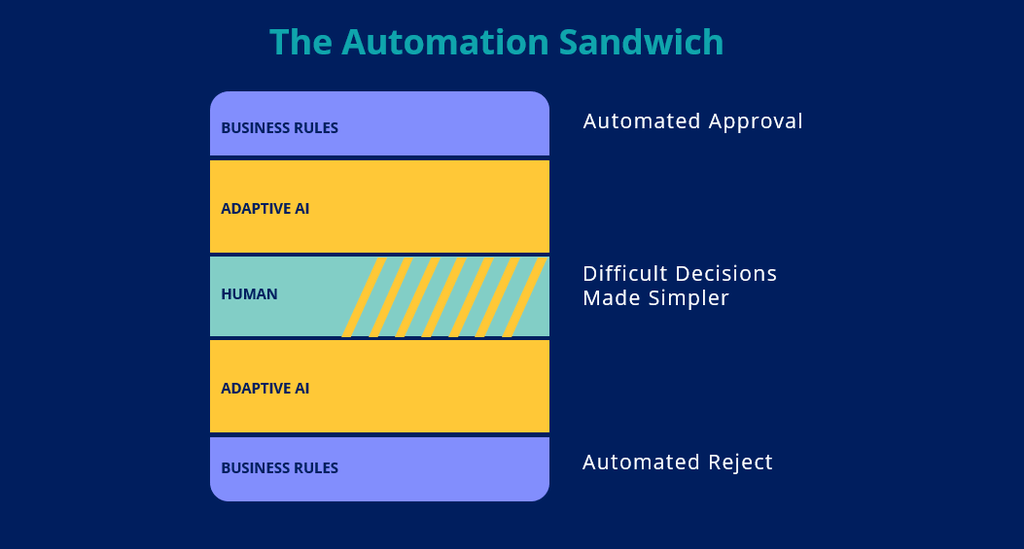Business rules have long afforded enterprises with the opportunity to automate huge volumes of decisions across their organizations. Despite those huge efficiency gains, employees remain saddled with the chore of making “obvious” decisions that are either too nuanced for business rules or too difficult to manage, either because of their complexity, or the dynamic nature of the business. Stealing focus from the most complex and nuanced cases in favor of repetitive, low-level work highlights a prime opportunity to take advantage of artificial intelligence (AI). While organizations often struggle with ‘big bang’ approaches to digital transformation, I’ve seen repeated successes when change is delivered in small, but valuable bites – using what I like to call “the automation sandwich approach.”
What is the “automation sandwich?”
The automation sandwich is one of the most common approaches to automated decision making I see in use amongst my clients. For the purposes of this blog, let’s use an approve or reject decision as an example. Using business rules, you’re able to automate the most obvious approvals and rejections. In the middle, you have all the less obvious decisions that an employee will have to make. With business rules for obvious decisions forming the bread and butter, and the less obvious decisions in the middle forming the meat, cheese, and veggies, you have what looks a little like a sandwich.
This approach has been hugely successful and has allowed staff to shift their focus away from attending to the most obvious decisions to focusing on ones with more nuance – where humans excel.
The issue, though, is that when you’re a large organization, you have enterprise-grade complexity. Many decisions involve nuances that are either too difficult to capture in business rules or nuances that makes capturing the details in business rules unmanageable. This results in humans making decisions that still feel very obvious.
Building enterprise-wide agility with adaptive AI
When faced with a situation like this, I’ve worked with my clients to bring in Adaptive AI to begin chipping away at the “obvious” human decisions. Adaptive AI, or “self-learning” AI, provides real-time insights for decisioning, and also automatically learns and evolves over time, maintaining high efficacy against changing business and environmental circumstances.
An adaptive model is a perfect fit for this situation because as your staff makes decisions across more and more scenarios, the model learns to predict the outcome with increasing confidence. Once the model is in place and learning, adding a simple business rule that leverages the AI (e.g. “If model confidence > x, then use model outcome, else route to human”) will improve results over time, as the model’s learning progresses.
An adaptive model is uniquely capable of discerning the nuances that make these obvious decisions too complex for simple business rules, with the added benefit of automating more and more decisions over time (without hands-on management by your team). Ultimately, your staff can focus their attention where it’s truly needed: on the most complex and nuanced decisions.
The journey doesn’t stop there
Now that you’ve reaped the benefits of adding AI into your workflows and decisions, how can you continue to take advantage of that technology -- even in the very center of the “automation sandwich?”
Automating decisions is a powerful use of AI technology, but it’s not the only use. Using models to create new data and insights which augment the information your employees have can help them work faster and more effectively. For example, natural language processing (NLP) can be used to pull key details out of longer free-text documents or fields, giving staff “at-a-glance” information, rather than making them read and extract that information themselves. In another use case, predicting the likely duration of a task could help prioritize the user’s work. And the list goes on and on.
For enterprise organizations whose employees are still burdened with making “obvious” decisions despite investments in automation with business rules, bringing AI into your automation sandwich can be a quick and inexpensive way to gain efficiencies in your workflows and free up your staff to complete more valuable work.
Stay tuned for other AI journeys clients have used to successfully optimize their workflows with AI.
Future-proof 2025: A look at top tech trends
From quick wins to ambitious advances – businesses that focus on the future won’t just survive: they’ll thrive.
Learn more
Kickstart your digital transformation journey with Pega
Trapped in digital chaos? Follow these steps for real transformation, one journey at a time.

